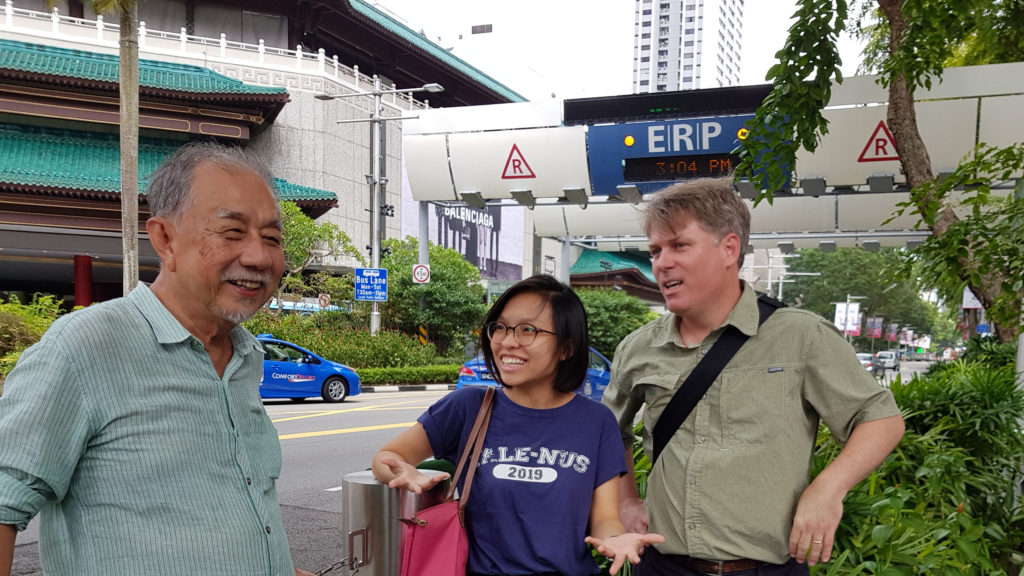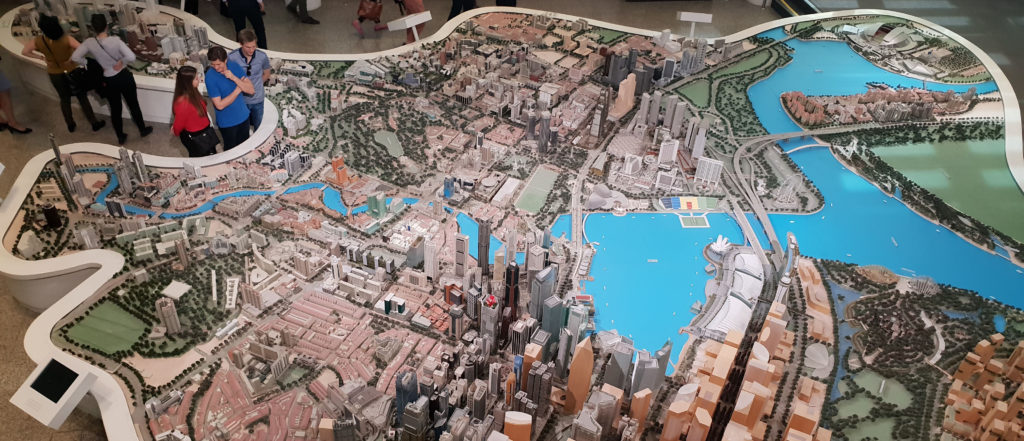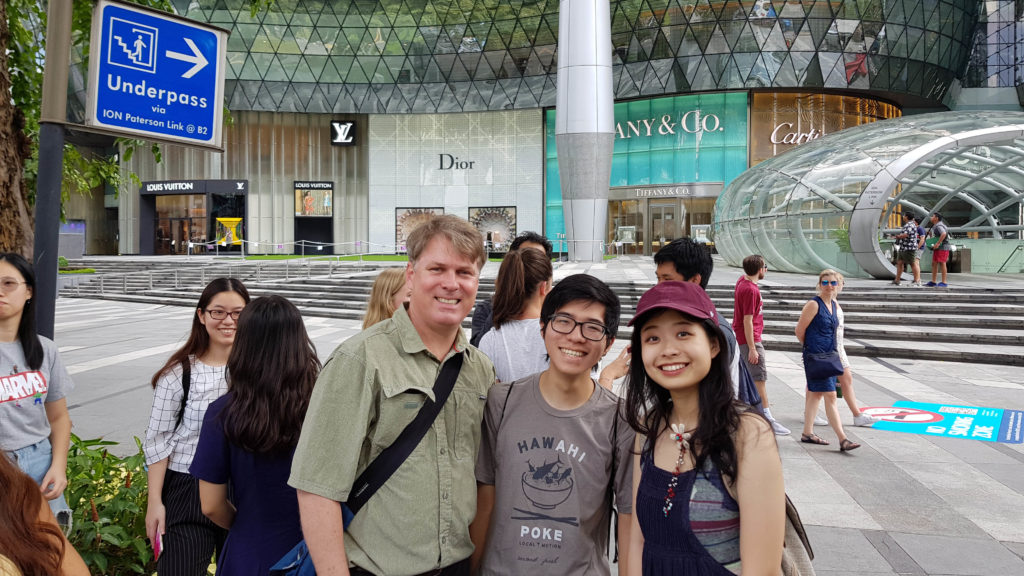Learning outside the classroom: Urban Singapore invites students to explore and experience the city
 Prof Chua Beng Huat (left) with Charlene Tan (centre) and Assoc Prof Erik Harms (right) in Orchard Road, Singapore, as part of a field trip for the Urban Singapore course. Image provided by Erik Harms.
Prof Chua Beng Huat (left) with Charlene Tan (centre) and Assoc Prof Erik Harms (right) in Orchard Road, Singapore, as part of a field trip for the Urban Singapore course. Image provided by Erik Harms.
Over the past semester, Charlene Tan (Class of 2019) found herself in different parts of Singapore on a weekly basis. The areas range from Toa Payoh, one of Singapore’s first housing estates to Orchard Road, the city-state’s main shopping district, and Geylang, an area known for its vibrant nightlife.
Charlene was exploring the urban history and culture of Singapore as part of the Urban Singapore course she was taking. Taught by Yale-NUS College Professor of Social Studies (Urban Studies) Chua Beng Huat, the course brought students out of the classroom to learn about Singapore as a thriving city-state.
Prof Chua explained that he had decided to offer a course on urban Singapore given that Yale-NUS was conveniently located in the city-state.
“Since Singapore has had an interesting and unique urban development as a city-state, which is increasingly uncommon, it made sense given our context to offer a course on the country’s urban planning and culture,” he said.
The course was divided into two components, Singapore’s urban planning and its urban culture. On the former component, students were brought on a walking tour of the city as well as visits to Singapore’s Urban Redevelopment Authority (URA) and Housing & Development Board (HDB).
“We looked at how the colonial city was planned and how the URA and HDB developed the commercial city and public housing estates following independence,” Prof Chua said.
To examine Singapore’s urban culture, Prof Chua brought students on a shopping tour along Orchard Road and conducted night fieldwork in Geylang and Ann Siang Hill. He also screened a local film “Eating Air” to examine how urban life was represented in cultural productions.
“One major component of everyday culture in Singapore is consumption, hence, we spent an afternoon shopping. What’s interesting is that because it is so much part of everyday life, we often don’t pay attention to what happens. Once you make it an intentional topic of observation, you start realising things that you took for granted that have become normalised in Singaporean life,” he explained.
Charlene had decided to take the class because she was interested in courses on Singapore.
She particularly enjoyed the field trip to Orchard Road because even though she has been to that part of Singapore many times, it was “pretty interesting what you notice when you’re actually paying attention to the activity itself.”
Like Charlene, Paul Jerusalem (Class of 2019) also took the course because he was interested in Singapore as an area of study. A Literature major, he was also “fascinated by the way place and geography are intertwined with history and sociology in complex ways.”
 Field trip to URA’s Singapore City Gallery. Image provided by Paul Jerusalem.
Field trip to URA’s Singapore City Gallery. Image provided by Paul Jerusalem.
His favourite field trip was the visit to the URA’s Singapore City Gallery, a three- storey visitor centre that documents the evolution of Singapore’s cityscape and urban planning across the decades.
“I’ve always been fascinated by maps and I used to read the Singapore Street Atlas just for fun when I was a child, so seeing 3D models of the city centre and detailed diagrams of the URA concept plans was a treat,” Paul shared.
The course was also unique because Prof Chua was not the only faculty member in the classroom. Associate Professor of Social Sciences (Anthropology) Erik Harms, who is visiting from Yale University, was attending the class as a student.
 Assoc Prof Erik Harms with students during the field trip for the Urban Singapore course. Image provided by Erik Harms.
Assoc Prof Erik Harms with students during the field trip for the Urban Singapore course. Image provided by Erik Harms.
He was funded by the Mellon New Directions Fellowship to take a year off from teaching and return to the classroom as a student in order to pursue new directions in his research and scholarship.
“I am originally trained as an anthropologist, but I increasingly study cities. For this reason, I have been taking courses in urban studies at Yale-NUS, including courses taught by Professors Jane M Jacobs, Chua Beng Huat and Assistant Professor Eun Jin Shin. These amazing courses have given me different tools for thinking about cities in new ways that complement my own training in urban ethnography,” he said.
He had decided to take Urban Singapore for two main reasons.
“Firstly, Prof Chua is a world-renowned scholar and taking the course offered me an amazing opportunity to interact with him and learn from him on a regular basis. His approach to thinking about cities is multidisciplinary and his perspective always forces me to think outside the box,” he said.
“Secondly, the course offers me a crash course in the history and contemporary planning of Singapore. I have spent many years researching Vietnamese cities and urban planners there often look for inspiration from Singapore so gaining first-hand experience learning about this city’s urban planning is not only useful in itself but also helps me deepen my understanding of other cities.”
In addition to learning from Prof Chua, Assoc Prof Harms said that taking the class has also been “extremely rewarding” because of the opportunity to interact with Yale-NUS students, whom he described as “so inquisitive and motivated”.
“In an undergraduate classroom, asking questions and revealing what one does not yet know can be one of the best ways to learn new things. I have benefitted a great deal from learning to ask about things I don’t know, and to work with my classmates to learn new things through this process of inquiry,” he said.





